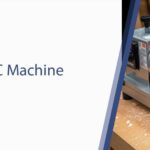In today’s rapidly evolving manufacturing landscape, Computer Numerical Control (CNC) design software stands as the indispensable backbone of precision engineering. For businesses like yours, striving for unparalleled accuracy, efficiency, and innovation, understanding and leveraging the right CNC design software isn’t just an advantage—it’s a necessity.
At Radonix, we specialize in empowering industries with cutting-edge solutions, and we deeply understand that the journey from concept to a perfectly machined part begins with robust and intuitive design tools.
This comprehensive guide delves into the world of CNC design software, exploring its profound impact on various industries, the critical features to look for, and how choosing the right software can redefine your manufacturing capabilities.
Whether you’re a seasoned engineer, a budding entrepreneur, or an educational institution, mastering CNC design software is your gateway to unlocking unprecedented levels of productivity and creativity.
What is CNC Design Software? The Digital Blueprint of Manufacturing
At its core, CNC design software refers to a suite of programs that allow engineers and designers to create detailed 2D and 3D models of parts and products.
These digital designs then serve as the precise instructions for CNC machines—such as mills, lathes, routers, and laser cutters—to fabricate physical objects with remarkable accuracy. Essentially, CNC design software acts as the crucial intermediary between human imagination and machine execution.
The process typically involves two main stages:
- CAD (Computer-Aided Design): This is where the actual design and modeling take place. Designers use CAD software to conceptualize, draw, and refine their parts in a virtual environment. Think of it as drafting with superpowers, allowing for incredible detail, easy modifications, and sophisticated simulations.
- CAM (Computer-Aided Manufacturing): Once a design is finalized in CAD, CAM software takes over. It translates the digital model into machine-readable code, often G-code, which dictates the precise movements, speeds, and tool paths of the CNC machine. This step is critical for ensuring the machine cuts, shapes, or engraves the material exactly as intended by the design.
While CAD focuses on what is to be made, CAM focuses on how it will be made by the machine.
Many modern CNC design software packages integrate both CAD and CAM functionalities seamlessly, offering an end-to-end solution from initial concept to machine-ready code.
The Unparalleled Advantages of Embracing CNC Design Software
The adoption of CNC design software has revolutionized manufacturing processes, moving far beyond the limitations of manual drafting and machining.
The benefits it offers are multi-faceted and directly impact a company’s bottom line and competitive edge.
1. Precision and Accuracy Beyond Human Capability
One of the most significant advantages of CNC design software is the unparalleled precision it facilitates. Digital designs can be created with micron-level accuracy, and the CAM software translates this into machine movements that replicate that precision. This eliminates human error inherent in manual processes, leading to:
- Consistent Quality: Every part produced is identical to the last, ensuring high product reliability.
- Reduced Waste: Less material is scrapped due to errors, leading to cost savings.
- Tighter Tolerances: The ability to achieve very close dimensional tolerances, critical for complex assemblies and high-performance components.
2. Enhanced Efficiency and Speed
Time is money in manufacturing, and CNC design software significantly accelerates the production cycle:
- Rapid Prototyping: Designers can quickly iterate on designs, create prototypes, and test concepts virtually before committing to physical production.
- Automated Tool Path Generation: CAM software automates the complex process of defining cutting paths, saving countless hours compared to manual programming.
- Lights-Out Manufacturing: With precise programming, many CNC machines can operate autonomously for extended periods, even overnight, maximizing machine utilization.
3. Cost Reduction Through Optimization
While there’s an initial investment in software and training, the long-term cost savings are substantial:
- Material Optimization: Software can simulate cuts and layouts to minimize material waste.
- Reduced Labor Costs: Automation reduces the need for constant human oversight during machining.
- Fewer Reworks and Defects: High precision leads to fewer defective parts, saving on material, labor, and time.
4. Unprecedented Design Freedom and Complexity
Gone are the days when design complexity was limited by the tools available. CNC design software empowers designers to create intricate geometries and complex shapes that would be impossible or exceedingly difficult to produce manually:
- Organic Shapes: Easily design curves, freeform surfaces, and organic geometries common in consumer products, medical devices, and artistic creations.
- Complex Assemblies: Design and simulate multi-part assemblies to ensure proper fit and function before manufacturing.
- Customization: Rapidly adapt designs for bespoke products, offering greater flexibility to meet unique client demands.
5. Improved Collaboration and Workflow
Digital design files foster better communication and collaboration across teams and even with external partners:
- Centralized Data: All design iterations and information are stored digitally, accessible to authorized personnel.
- Version Control: Easily track changes and revert to previous versions if needed.
- Remote Collaboration: Teams can work on projects from different locations, sharing and reviewing designs seamlessly.
Key Features to Look for in Top-Tier CNC Design Software
Choosing the right CNC design software is a critical decision that can significantly impact your operational efficiency and product quality.
Here are the essential features to prioritize when evaluating options for your specific needs, keeping in mind the expertise Radonix brings to selecting optimal solutions.
1. Intuitive User Interface (UI) and User Experience (UX)
A powerful software is only as good as its usability. A well-designed UI/UX reduces the learning curve, boosts productivity, and minimizes frustration. Look for:
- Clean Layout: Easy-to-navigate menus and toolbars.
- Customizable Workspace: Ability to tailor the interface to your preferred workflow.
- Contextual Help: On-demand assistance and clear explanations for tools.
2. Robust 2D and 3D Modeling Capabilities (CAD)
The core of any CNC design software lies in its CAD functionalities. Ensure it offers:
- Parametric Modeling: The ability to define relationships between design elements so that changes to one feature automatically update related features. This is crucial for efficient design modifications.
- Direct Modeling: Allows for pushing and pulling faces, edges, and vertices for quick conceptualization and modification.
- Surface and Solid Modeling: Support for both approaches, enabling the creation of both rigid, precise parts and more organic, aesthetic forms.
- Assembly Design: Tools to design and simulate the interaction of multiple parts within a larger assembly.
3. Advanced CAM Functionalities and Toolpath Generation
The seamless transition from design to machining is paramount. Your software should provide:
- Comprehensive Toolpath Strategies: Support for various machining operations, including 2-axis, 3-axis, 4-axis, and 5-axis machining, turning, milling, drilling, and more.
- Tool Library Management: A well-organized system for defining and managing cutting tools, including their geometry, speeds, and feeds.
- Simulation and Verification: The ability to simulate toolpaths virtually to detect collisions, optimize cuts, and visualize the machining process before it happens on the machine. This saves significant material and machine wear.
- Post-Processing: The crucial ability to generate machine-specific G-code for your particular CNC machine controllers. Without robust post-processors, your CAD/CAM files are useless to the machine.
4. Material and Toolpath Optimization Features
Efficiency isn’t just about speed; it’s about smart resource utilization:
- Nesting: Optimizing the arrangement of parts on a sheet of material to minimize waste, particularly for laser cutting and routing.
- Collision Detection: Automatically identifying potential crashes between the tool, workpiece, and machine components during simulation.
- Chip Load and Feed Rate Optimization: Adjusting cutting parameters for optimal material removal rates and tool life.
5. Data Import/Export and Interoperability
In a collaborative environment, your software needs to play well with others:
- Broad File Format Support: Ability to import and export common CAD file formats (e.g., STEP, IGES, STL, DWG, DXF) to collaborate with other software and systems.
- Cloud Integration: For easy sharing, version control, and remote access to projects.
6. Integrated Simulation and Analysis Tools
Beyond just visualizing toolpaths, look for features that allow for deeper analysis:
- FEA (Finite Element Analysis) Integration: For simulating how parts will behave under stress, heat, or vibration, ensuring structural integrity.
- Tolerance Analysis: To understand how manufacturing variations might affect part fit and function.
7. Scalability and Customization
Your software should grow with your business and adapt to your unique needs:
- Modular Design: The option to add functionalities as your requirements evolve.
- API (Application Programming Interface): For advanced users to create custom scripts or integrations with other systems.
8. Strong Community Support and Learning Resources
Even the best software requires ongoing learning and support:
- Comprehensive Documentation: User manuals, tutorials, and help files.
- Active User Community: Forums, online groups, and webinars where users can share knowledge and troubleshoot.
- Responsive Technical Support: Access to expert assistance from the software vendor.
Popular CNC Design Software Options in the Market
The market for CNC design software is vast and varied, catering to different industries, budgets, and skill levels. Here at Radonix, we encounter a wide range of these powerful tools.
While we don’t endorse one over another universally, as the best choice always depends on your specific application, here’s an overview of some of the most prominent and widely-used options, each with its unique strengths:
- Fusion 360 (Autodesk)
- Strengths: An incredibly versatile cloud-based platform that integrates CAD, CAM, CAE (Computer-Aided Engineering), and PCB design. It’s known for its intuitive interface, strong community support, and affordability, making it popular among startups, small to medium businesses, and hobbyists. Its generative design capabilities are also a significant draw.
- Best For: Product design, rapid prototyping, hobbyist CNC, small workshops, educational institutions.
- SolidWorks (Dassault Systèmes)
- Strengths: A industry-standard, powerful CAD software with robust CAM add-ons (like SolidWorks CAM powered by CAMWorks). It’s renowned for its parametric modeling capabilities, extensive feature set for complex part and assembly design, and strong simulation tools. It has a massive user base and a wealth of learning resources.
- Best For: Mechanical design, complex assemblies, industrial machinery, professional engineering firms.
- Mastercam (CNC Software, Inc.)
- Strengths: One of the most widely used CAM software packages globally, Mastercam excels in generating highly optimized toolpaths for a vast array of CNC machines, including multi-axis milling and turning. It’s known for its powerful machining strategies and extensive post-processor library. While it has some CAD capabilities, it’s primarily a CAM powerhouse.
- Best For: Advanced manufacturing, complex machining operations, large-scale production, shops needing extensive CAM control.
- Vectric VCarve Pro / Aspire
- Strengths: Specifically designed for CNC routing and engraving, these software packages are incredibly user-friendly for 2D and 2.5D machining. VCarve Pro is excellent for signage, wood carving, and decorative work, while Aspire adds powerful 3D modeling and sculpting capabilities. They are popular for their ease of use and excellent results in woodworking and artistic applications.
- Best For: Woodworking, sign making, artistic carvings, 2D/2.5D machining, hobbyist routers.
- AutoCAD (Autodesk)
- Strengths: While primarily a 2D drafting software, AutoCAD remains a staple in many industries for its precision and comprehensive drawing tools. It’s often used for creating initial 2D layouts and designs that are then imported into more advanced 3D CAD/CAM software.
- Best For: 2D drafting, architectural design, engineering documentation, when precise 2D layouts are the primary need before moving to 3D.
- Siemens NX
- Strengths: A high-end, integrated CAD/CAM/CAE solution known for its advanced capabilities in product design, engineering, and manufacturing. Siemens NX is a powerhouse for complex surface modeling, large assemblies, and advanced machining strategies, often used in aerospace, automotive, and heavy machinery industries.
- Best For: Enterprise-level manufacturing, highly complex product development, aerospace, automotive.
- Rhino & Grasshopper (Robert McNeel & Associates)
- Strengths: Rhino is renowned for its freeform surface modeling capabilities, making it popular in industrial design, architecture, and jewelry design. Grasshopper, a visual programming language integrated with Rhino, allows for algorithmic design and parametric control, opening up possibilities for highly complex and iterative designs. While primarily CAD, there are CAM plugins available.
- Best For: Industrial design, jewelry design, architecture, artistic fabrication, complex freeform surface modeling, algorithmic design.
Choosing the Right CNC Design Software
Selecting the ideal CNC design software is a critical strategic decision that can define your manufacturing success. At Radonix, we guide our clients through this process by emphasizing a holistic approach that considers not just current needs, but future aspirations.
Here’s a structured approach to making an informed decision:
1. Define Your Specific Needs and Objectives
Before even looking at software, clearly articulate what you need it to do. Ask yourself:
- What type of parts will you be designing and machining? (e.g., simple 2D components, complex 3D prototypes, artistic carvings, multi-axis aerospace parts)
- What materials will you be working with? (e.g., wood, metal, plastic, composites)
- What types of CNC machines do you operate or plan to acquire? (e.g., 3-axis mill, 5-axis router, lathe, laser cutter) Ensure the software has robust post-processors for your specific machines.
- What is your budget? Consider both initial purchase or subscription costs and ongoing maintenance/support.
- Who will be using the software? Consider their current skill level and willingness to learn new tools.
- What is your current workflow? How will the new software integrate with existing systems?
2. Assess Your Team’s Skill Set and Learning Curve
Software adoption success heavily relies on user proficiency.
- Ease of Use: Is the software intuitive enough for your team to pick up quickly?
- Training Resources: What kind of tutorials, documentation, and support are available? Does the vendor offer professional training?
- Community Support: An active online community can be an invaluable resource for troubleshooting and learning.
3. Consider Integration and Scalability
Your software should not be a standalone island.
- Interoperability: Can it seamlessly import and export data from other software you use (e.g., engineering analysis tools, ERP systems)?
- Future Growth: Can the software scale with your business? Will it support more complex projects, additional machines, or new manufacturing processes as you grow? Are there modular add-ons for advanced features you might need later?
4. Evaluate Post-Processor Quality and Customization
This is often overlooked but absolutely crucial.
- Machine Compatibility: Does the software offer reliable post-processors for your specific CNC machine and controller (e.g., Fanuc, Haas, Siemens, Mach3)?
- Customization: Can post-processors be customized to generate specific G-code formats or incorporate unique machine functions? This is vital for optimizing machine performance.
5. Don’t Overlook Support and Updates
Software is an ongoing investment, and reliable support is key.
- Technical Support: What kind of support does the vendor offer (phone, email, online portal)? What are their response times?
- Regular Updates: Does the software receive regular updates with new features, bug fixes, and compatibility improvements?
- Licensing Model: Understand if it’s a perpetual license, subscription, or token-based.
6. Leverage Trials and Demos
The best way to know if software fits is to try it yourself.
- Free Trials: Take advantage of free trial periods to put the software through its paces with your own projects.
- Vendor Demos: Request personalized demonstrations from software vendors to see how their solution addresses your specific challenges.
- Talk to Other Users: Connect with other companies in your industry who use the software to get their honest feedback.
At Radonix, we don’t just talk about CNC design software; we implement solutions that drive real-world results. We understand that the right software, coupled with expert implementation and training, transforms your manufacturing capabilities.
The Future of CNC Design Software
The realm of CNC design software is continuously evolving, driven by advancements in artificial intelligence, cloud computing, and additive manufacturing. Staying abreast of these trends is crucial for businesses aiming to maintain a competitive edge. At Radonix, we closely monitor these developments to ensure our clients are always at the forefront of manufacturing innovation.
1. Artificial Intelligence (AI) and Machine Learning (ML)
AI and ML are set to revolutionize how we design and manufacture:
- Generative Design: AI algorithms automatically generate multiple design options based on specified parameters (e.g., material, load, manufacturing process, weight constraints). This allows designers to explore a vast solution space far beyond human capacity, leading to lighter, stronger, and more efficient parts.
- Predictive Maintenance: AI-driven analysis of machine data can predict when maintenance is needed, minimizing downtime and optimizing machine utilization.
- Automated Toolpath Optimization: ML can learn from past machining operations to suggest optimal toolpaths, speeds, and feeds, leading to increased efficiency and reduced tool wear.
- Defect Detection: AI-powered vision systems can detect manufacturing defects in real-time, ensuring higher quality control.
2. Cloud-Based CAD/CAM Solutions
The shift to cloud computing offers significant advantages:
- Accessibility: Design and manufacturing data can be accessed from anywhere, on any device, fostering remote work and global collaboration.
- Scalability: Cloud resources can be easily scaled up or down based on project demands, eliminating the need for expensive hardware investments.
- Automatic Updates: Software updates are managed by the vendor, ensuring users always have the latest features and security patches.
- Enhanced Collaboration: Real-time collaboration features allow multiple users to work on the same project simultaneously.
3. Integration with Additive Manufacturing (3D Printing)
As additive manufacturing grows, its synergy with traditional subtractive CNC processes becomes more pronounced:
- Hybrid Manufacturing: Software increasingly supports workflows that combine 3D printing for complex geometries with CNC machining for precision finishing.
- Design for Additive Manufacturing (DfAM): New software tools are emerging that help designers optimize parts specifically for 3D printing processes, taking advantage of unique capabilities like lattice structures and part consolidation.
- Material Science Integration: Software is incorporating more sophisticated material models to simulate the behavior of various materials in both additive and subtractive processes.
4. Augmented Reality (AR) and Virtual Reality (VR) in Design and Simulation
AR and VR are transforming how we visualize and interact with designs:
- Immersive Design Review: Engineers can step inside their designs in VR, identifying potential issues or design flaws that might be missed on a 2D screen.
- Virtual Prototyping: Test and validate product functionality in a virtual environment, reducing the need for costly physical prototypes.
- Operator Training: AR/VR can provide immersive training environments for CNC machine operators, simulating real-world scenarios without risk.
5. Digital Twin Technology
The concept of a “digital twin” – a virtual replica of a physical product or process – is gaining traction:
- Real-time Monitoring: Data from physical CNC machines can be fed back into the digital twin, allowing for real-time monitoring of performance, wear, and potential issues.
- Predictive Optimization: Use the digital twin to simulate “what-if” scenarios, optimizing machining parameters, maintenance schedules, and production flows without impacting actual operations.
These trends highlight a future where CNC design software is not just a tool for creating G-code, but a comprehensive, intelligent platform that guides the entire product lifecycle from concept to delivery.
At Radonix, we are committed to helping you navigate this exciting future, ensuring your manufacturing processes are always at the peak of innovation and efficiency.
Elevate Your Manufacturing with Radonix and the Right CNC Design Software
In the competitive landscape of modern manufacturing, the ability to rapidly innovate, produce with precision, and operate with maximum efficiency is paramount. At Radonix, we believe that the right CNC design software is not merely an expense; it is a strategic investment that unlocks these capabilities.
We understand that the journey from concept to finished product is complex, and every step, especially the initial design and programming phase, requires robust, reliable, and intelligent tools.
From guiding you through the selection of the perfect CNC design software tailored to your specific industry and operational scale, to providing expert consultation on optimizing your entire workflow, Radonix is your trusted partner.
Embracing advanced CNC design software empowers you to:
- Achieve unprecedented levels of precision and quality in every component you produce.
- Dramatically reduce production times and material waste, leading to significant cost savings.
- Unleash your design team’s creativity, enabling them to tackle complex geometries and innovative products that were once impossible.
- Position your business at the forefront of technological advancement, ready to integrate future innovations like AI-driven design and digital twins.
Whether you’re looking to upgrade your current software, implement a new solution from scratch, or simply understand how to maximize the potential of your existing CNC design software, Radonix is here to provide the expertise and support you need. Our commitment is to help you transform your manufacturing vision into tangible, high-quality results.
Ready to revolutionize your manufacturing processes with the power of advanced CNC design software?
Contact Radonix today for a personalized consultation, and let us help you select and implement the perfect software solution to drive your success.
Contact Us:
- E-Mail: info@radonix.com
- Phone: +90 (553) 920 5500








